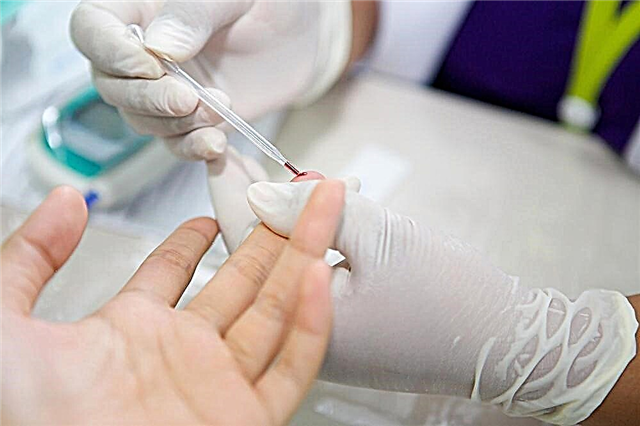
Currently, more and more couples are faced with the difficulty of conceiving a baby. Not always such an intimate problem is associated with a woman. It also happens that difficulties with conception are observed in a man.
To diagnose reproductive pathologies that can lead to the impossibility of natural conception, specific studies are required. One of them is the mar test.

What it is?
Several types of studies are required to assess male fertility (fertility). They are appointed by an andrologist or urologist after an extended clinical examination of a man.
During this routine diagnostic procedure the doctor identifies external signs various pathologies of the genital organs. If during the examination the doctor suspected some kind of illness, then he will prescribe laboratory tests to the man.
Spermogram and MAR test are the most common and frequently prescribed types of examinations. In most cases, only the first research method is sufficient.
With the help of this analysis, the doctor can determine how mobile and active the male reproductive cells are, and also establish the number of leukocytes in the ejaculate. This examination helps the specialist to obtain overview information about the state of men's health.

However, in some cases, this is not enough. In this situation, the doctor will prescribe the MAR test for the man. In fact, this study is immunological... It is necessary in order to determine whether an immune factor is present in the development of infertility.
The abbreviation of the test gives us an idea of the essence of the study. The full title of this study in English is Mix antiglobulin reaction. Russian-speaking experts call it a mixed antiglobulin reaction.

The essence of the research is determine the percentage of sperm cells in semen associated with class A and G immunoglobulins (igA, igG)as well as to determine antisperm antibodies.

There are 2 variants of this study. The most commonly used is the direct method. In this case, the percentage of male germ cells is determined, which is associated with immunoglobulins A and G. In an indirect diagnostic method, the relationship between the percentage of spermatozoa is also assessed, but already with the titer of antisperm antibodies.

It is important to note that this study is an international standard. It is successfully used by specialists all over the world. This method is necessary for all couples who really want to become parents.
It is very important to understand the difference between this method and spermogram. This analysis allows you to assess the ability to fertilize even in active sperm.

In the case of semen analysis, they will be labeled as healthy or normal. Using the mar-test, it is possible to assess their suitability or unsuitability for fusion with the egg. This study reveals more "hidden" causes of infertility.
This diagnostic method became possible thanks to the use of mixed agglutination reactions. It is this method that makes it possible to identify immunological disorders at the level of spermatogenesis.

In what cases is it indicated?
It makes no sense to conduct this examination for absolutely all men. In medicine, there are certain medical indications for all research, including for the mar-test.
This laboratory analysis is prescribed when:
- planned conception of a child, when both members of the couple are preparing for this event;
- the presence of infertility;
- during routine preparation prior to in vitro fertilization (IVF, ICSI or insemination);
- a pathological condition when the sperm begin to stick together strongly;
- the consequences of infectious pathologies of the reproductive organs.

What does it show?
This analysis reveals an immunological variant of infertility. In the development of this pathological condition, special protein substances are guilty - antisperm antibodies. Interacting with sperm, they have a negative effect on them. This leads to the fact that male cells cannot perform all the functions laid down on them by nature.
It is important to note where antisperm antibodies are generated. Class A immunoglobulins are synthesized in the male epididymis and testes. IgG comes from the systemic circulation. They not only "attack" the sperm, but also lead to the formation of a special antisperm membrane around them.

Scientists have established in which cases the amount of antisperm antibodies increases. Various injuries and damage to the area of the external inguinal organs can lead to this.
It often happens that during the examination and collection of anamnesis, the doctor determines that such an episode occurred in childhood. However, for quite some time, the man was not bothered by anything. For many years, he did not know about the existence of such a problem.
Also, various infectious diseases can lead to an increase in the level of antisperm antibodies in the blood. And not only the genitals. Diseases of the urinary organs are one of the possible reasons for the development of this condition. This feature is largely due to the anatomical proximity of the organs.

Surgical operations performed on the scrotum, can also cause an increase in antisperm antibodies in a man's blood. In this case, the development of pathology leads to traumatic damage to the anatomical border between the blood vessels and the seminiferous tubules.
The "attack" of antisperm antibodies on spermatozoa promotes various failures in the functioning of the immune system. The reasons described above lead to such situations. Doctors also associate this process with the fact that the blood-testicular barrier (the border between the blood vessels and testicular tissue) is violated.

In what cases is it not carried out?
As with any research method, there are contraindications for the MAR test. So, this analysis is not carried out if there is an almost complete absence of male germ cells in the ejaculate.
Also, this research is not performed, if the sperm count is too low and insufficient in order to fully implement their count.


In this situation, it is almost impossible for a laboratory assistant to study the required parameters. In this case, the MAR test will simply be uninformative.
How is it done?
The choice of a methodology largely depends on how the study will be conducted - direct or indirect. In the first situation, sperm is required directly for the study. To perform the second type of analysis, blood serum is required.
According to statistics, the direct research method is used in medical practice more often. The results of such laboratory tests are more accurate and reliable. However, experts recommend that you still perform both of these tests. In this situation, the doctor receives all the information he needs about the properties of sperm cells and the state of the immune system.

As a rule, this diagnostic method is combined with a spermogram.
Ejaculate is required for the study. The man collects it with the help of masturbation. There is no need to donate semen separately for spermogram and mar-test. With sufficient material, this should be enough for both studies.
Before donating sperm for research, a man should prepare. A couple of days before the examination do not contact with any chemical and toxic substances.

A week before the delivery of the biomaterial, sexual abstinence is prescribed. To a greater extent, this is required so that the husband's ejaculate later collected does not contain the vaginal secretion of his wife.

2-3 days before going to the laboratory, the use of any alcoholic beverages is limited. Smoking the day before the study should also be limited. If such a restriction is too severe for a man, then he should not smoke for at least 6-8 hours before donating sperm.
Under the influence of nicotine and alcohol, the studied parameters in the spermogram and the result of the mar-study may change.

Also very it is important to warn the doctor in advance about what medications the man is taking. So, with prolonged use of hormonal agents, the indicators of the tests performed can be changed. If a man has been taking such medicines or anabolic steroids for 6-8 months or more, then he should definitely consult with his doctor before submitting the material for research.

Also two days before the examination you should not be actively involved in sports... Intense exercise in the gym can lead to a change in hormonal levels. This may contribute to the fact that the obtained research results are unreliable.
In case a man is receiving treatment for some diseases of the urinary system, then it is better for him to postpone this study to a later date. To obtain reliable results of the analysis, doctors advise, if possible, to exclude taking any medications.
It is better to do this at least 8-10 days before the delivery of the biomaterial.

The analysis time can vary. This largely depends on the material and technical base of the laboratory, as well as its workload.
Some medical institutions issue the results of the tests performed the next day after the delivery of the biomaterial. In others, the readiness of the result, as a rule, is 2-3 days... If the analysis is required to be rechecked, then retest after 2-3 weeks.

Normal indicators
The conditional norm is a condition that doctors call "normozoospermia". Such a diagnosis is made after a spermogram.
To establish this condition, it is necessary that the semen contains 60-150 million male germ cells. At the same time, at least 70% must be active and viable. This condition is most often diagnosed by doctors in men under 35. Unfortunately, the older a man gets, the higher his risk of developing various disorders.

Normal sperm counts are not at all a guarantee of 100% conception of a baby. The MAR test helps to clarify this probability.
If its indicators do not reveal various pathologies, then in such a situation male fertility is usually high.
How is the interpretation of the results carried out?
The doctor must decipher the results of the analysis. It is quite difficult to do this on your own. Often, doctors use special tables that allow them to determine the boundaries of the norm of the studied parameters. This helps the doctor to correctly diagnose and choose the necessary treatment tactics.
The analysis is deciphered in the laboratory by how many anti-sperm antibodies surround male germ cells. This sign is assessed using a microscope.

If in the studied field of view the laboratory assistant sees balls, then this indicates the combination of antisperm antibodies with the sperm. After their visual determination, a quantitative calculation is made. Then the normal, active sperm are counted. The percentage of healthy and damaged cells is then mathematically calculated. In the future, it is this clinical indicator that will be used by the doctor to establish a diagnosis.
A qualitative analysis also provides for the fact that the laboratory assistant will necessarily take into account exactly where antisperm antibodies to sperm are attached. This attachment can be in the head, body or tail area.
The larger the area of contact, the higher the degree of damage, and the more unfavorable the prognosis for the development of this pathology.

The best version of the result obtained is negative. It means that the man is healthy and has no signs of immunological infertility. It is important to remember that the parameters of the norm in this situation are very conditional. That is, this suggests that there are no problems only with regard to immunological infertility. However, even in this situation, this is not a 100% guarantee of conception.
If the test result is negative, this indicates that the sperm contains quite a lot of active and, most importantly, sperm cells capable of fertilizing eggs. The more healthy male germ cells, the higher the male fertility rates.

If, after the study, a positive result is obtained, then this is a sign that there are serious problems in the male body. Typically, this conclusion is made when more than 50% of the sperm are "defective" in fertility.
The result obtained is indicated as a percentage. In this way, the higher the percentage, the lower the couple's ability to naturally fertilize.

A positive test is the appearance of 25-50% of male germ cells, which are associated with antisperm antibodies. A negative result is a situation when up to 10-25% of such immune complexes have been identified in the analysis. For example, if the semen contains only 0-3% of damaged sperm, then a man should not worry about this. This indicator is considered the norm.
Moreover, the indicators are necessarily evaluated separately for each class of immunoglobulins. Normally, for both IgG and IgA, the number of sperm bound with antisperm antibodies will be from 1 to 10%. In some cases, there is also their complete absence. In such a situation, the analysis will result in a value of zero.

An increased level of class A immunoglobulins (above 40%) indicates that the blood-testicular barrier is disturbed. After he recovers and igA readings will gradually return to normal. This usually takes about a year.
The result of the studies carried out in most of the surveyed men, as a rule, is weakly positive or negative. However, it also happens that 100% of damaged spermatozoa are found in the presented sample. In this case, unfortunately, the probability of conceiving a child tends to zero.
In this situation, modern methods of artificial insemination can help a couple become parents. Plus, you should definitely carry out treatment.
What should be done?
When a positive test result appears, it is very important to immediately consult a doctor. It is important to establish the cause that influenced the development of this pathology. For this, the doctor will definitely prescribe additional research methods.
If the cause of the condition that has arisen is the consequences of previous operations, you should seek advice from the urologist operating it. In some situations, additional surgical methods are required to correct the violations that have arisen.

A prerequisite for additional diagnostics is the delivery of tests for sexually transmitted diseases. It often happens that a man is not tested for such infections. Many of them quickly become chronic. In this case, it is impossible to achieve a positive result without treatment of the underlying disease.
All men over the age of 40 should definitely monitor the health of the prostate gland. To do this, you need to visit a urologist at least once a year... During a clinical examination, the doctor will be able to identify an increase or neoplasm in the organ.

In such a situation, he will definitely recommend his patient to donate blood for PSA (prostate-specific antigen) and undergo an ultrasound of the prostate gland.

If, according to the results of the mar-test, a man was diagnosed with immunological infertility, then he should immediately prepare for the fact that the treatment of this condition can be quite long.
The complex of therapy includes both medications and physiotherapy techniques. Also, individual recommendations on the correction of the daily routine are compiled, and the necessary diet is selected.
For more information on what a MAR test is, see below.



